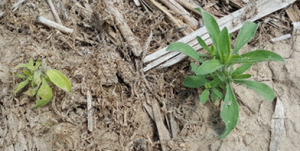
A while ago, I wrote a post summarizing the pros and cons of using a regulatory framework to slow the evolution of herbicide resistant weeds. As a part of that post, I suggested there exists a “resistance management paradox.” In a nutshell, to reduce the problem of herbicide resistant weeds, one important strategy may be to actually use more herbicide. From my previous post:
“The only way to assuredly prevent herbicide resistance from evolving is never to apply the herbicide; but if we are going to use a herbicide, the best way to minimize herbicide resistant weed evolution may be to increase herbicide use. Research from Hugh Beckie and Xavier Reboud has shown that mixtures of two herbicides are far more effective at slowing the evolution of herbicide resistant weeds compared to an annual rotation of herbicides.”
When Beckie & Reboud used a herbicide by itself just one time over a 4 year period, they observed a nearly 8-fold increase in resistant weed seed production. However, if they applied the same herbicide every year, but mixed it with another effective herbicide, resistant weed prevalence remained statistically the same as if they had never used the herbicide at all.
| Resistant seed produced per square meter averaged over 4 years | Percent of weed seed in soil that was resistant after 4 years | |
| Never used ALS herbicide | 155 | 4 |
| Used ALS herbicide once over 4 years | 1210 | 29 |
| Used ALS herbicide every year, mixed with 2nd herbicide | 178 | 8 |
| Data from Beckie & Reboud (2009) | ||
A new study published earlier this year in the journal Pest Management Science lends additional evidence for the resistance management paradox. The goal of this new study from Illinois was to “identify risk factors associated with resistance.” Their work is pretty unique in the herbicide resistance literature because they used an epidemiological approach. They used a case-control design common in the medical literature to determine whether exposure to various factors was associated with development of herbicide resistance. For this study, the researchers used glyphosate-resistant common waterhemp as their model species, and obtained field management data for a few hundred crop fields over a 300 square mile area over an 8 year period. They evaluated 66 different environmental and landscape conditions and various management practices that were thought to potentially influence resistance development in some way.
Unsurprisingly, their results suggested that management practices, especially herbicide choices, were the most predictive factors in the development of glyphosate-resistance. Glyphosate-resistance was most prevalent in fields where glyphosate was used frequently, and where few herbicide modes of action were used. But at least one of the results has surprised some weed scientists. From the study (emphasis mine):
“Contrary to prevailing wisdom, both binary and proportional models indicated that herbicide turnover increased the frequency of resistance. Logistic regression models supported this result, with positive or non-significant effects of several metrics of herbicide MOA turnover…”
That’s an overly science-y way of saying that rotating herbicides from year to year increased the likelihood of finding herbicide resistant weeds. For many years, rotating herbicides annually has been a primary recommendation from weed scientists; if you use Roundup Ready with glyphosate this year, you should use something else next year. Rotating herbicides from year to year will decrease the frequency of any single herbicide, thereby reducing selection for those resistant weeds. But herbicide rotation, on its own, isn’t enough and we’ve known this for a while. From a review article written by Jason Norsworthy and others regarding best management practices (page 40, emphasis mine):
“Annual herbicide rotations are useful but not sufficient because they subject a weed population to a single [herbicide mode of action] at a time…”
I think there are a few important takeaways from the Illinois research. First, rotation of herbicide modes of action simply isn’t enough to prevent (or, perhaps, even significantly delay) the appearance of herbicide resistance. Weed scientists and extension specialists need to be more clear about this in our education efforts. It seems that farmers in the Illinois study may have had a false sense of security from rotating herbicides, since they were actually more likely to develop herbicide resistant weeds compared to farmers who weren’t rotating. Rotating herbicides from year to year is only effective if it is also accompanied by other effective weed control measures.
This research supports the potential value of stacked herbicide technologies like Enlist and Roundup Extend as tools for resistant weed management, since they will increase the likelihood that farmers will apply mixtures of effective herbicide modes of action. However, these technologies will be most beneficial only where resistance to glyphosate has not yet evolved. Where glyphosate-resistance is prevalent we will simply be selecting for weeds that are resistant to both herbicide modes of action in Enlist (2,4-D) or Extend (dicamba) systems. This is the “pesticide treadmill” that critics of the technology worry about, which is a valid, and serious, concern. For herbicide mixtures to be most effective, they must be initiated before herbicide resistance is a major problem.
In my previous post on the resistance paradox, I wrote:
“If we consider herbicide-resistant weeds to be an environmental problem that must be addressed, one strategy we must seriously contemplate is increasing herbicide use.”
I still believe that to be true. Unless we plan on completely removing herbicides from modern agriculture (a laudable long-term goal, but unrealistic in the short-term), we need to try and protect the utility of the herbicides we have. Since herbicide rotations are ineffective on their own, the most practical way to maintain the value of current herbicides is to mix them with other effective herbicides. This will almost certainly increase the total amount of herbicides we use.
But “spray more herbicides” is not something anyone wants to hear, including me. (Well, maybe some herbicide manufacturers.) Society wants us to decrease pesticide use. Farmers certainly don’t like spending money on more pesticides. So at some point, we must stop looking to herbicides as the solution to a problem created by herbicides. You know what they say about someone who keeps doing the same thing over and over again while expecting a different result. We need to place more emphasis on non-chemical weed management practices. This means taking some pages from agroecology and the organic weed management playbook. We need to make more regular use of cultural weed control practices like smother crops and stale seedbeds. We need to invest in more mechanical weed management technologies like robotics and seed destructors. Perhaps we’ll even have to reduce some of the benefits that have accrued from adoption of no-till production. I certainly don’t have a magical solution to the herbicide resistance problem. But I can guarantee that a long-term solution will not be simple, and it most certainly won’t be sold in a jug.
UPDATE: if you’re interested in how easy it is to implement the multiple herbicide strategy on an actual farm, see this post.


Comments are closed.